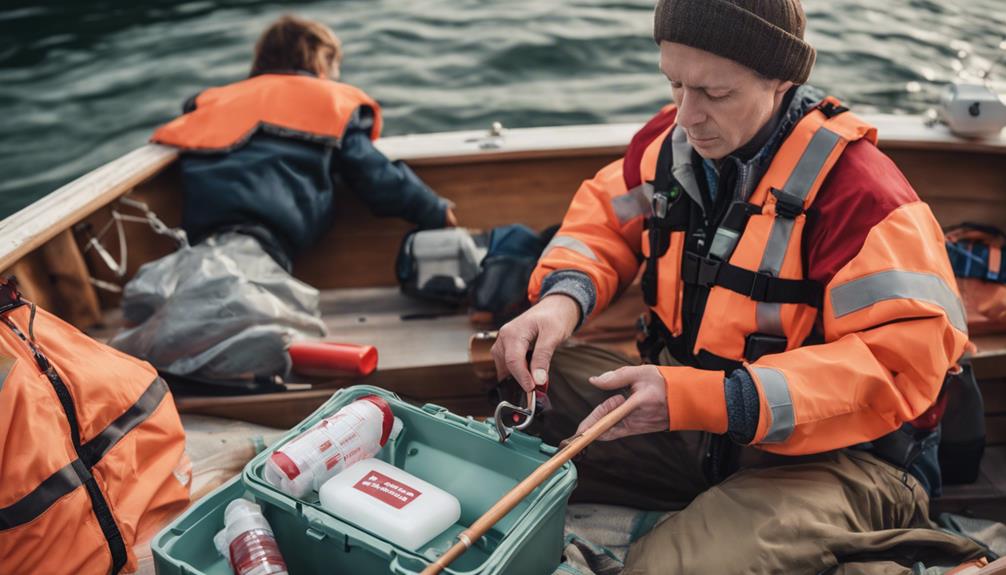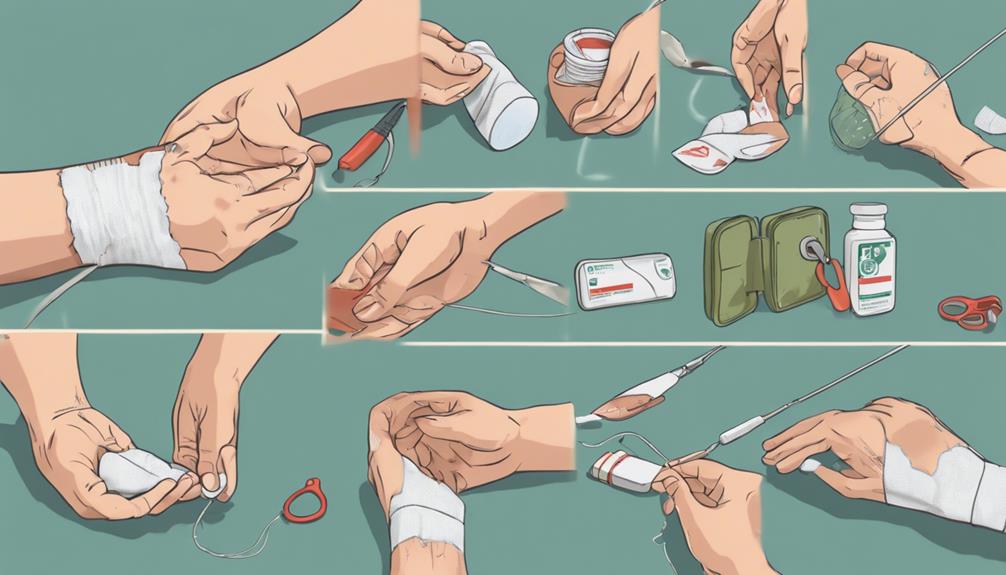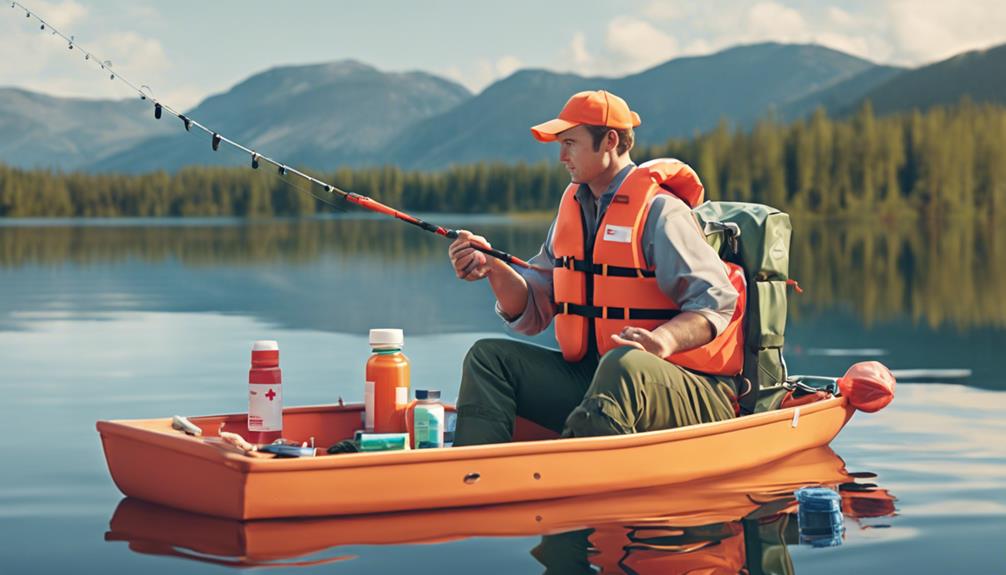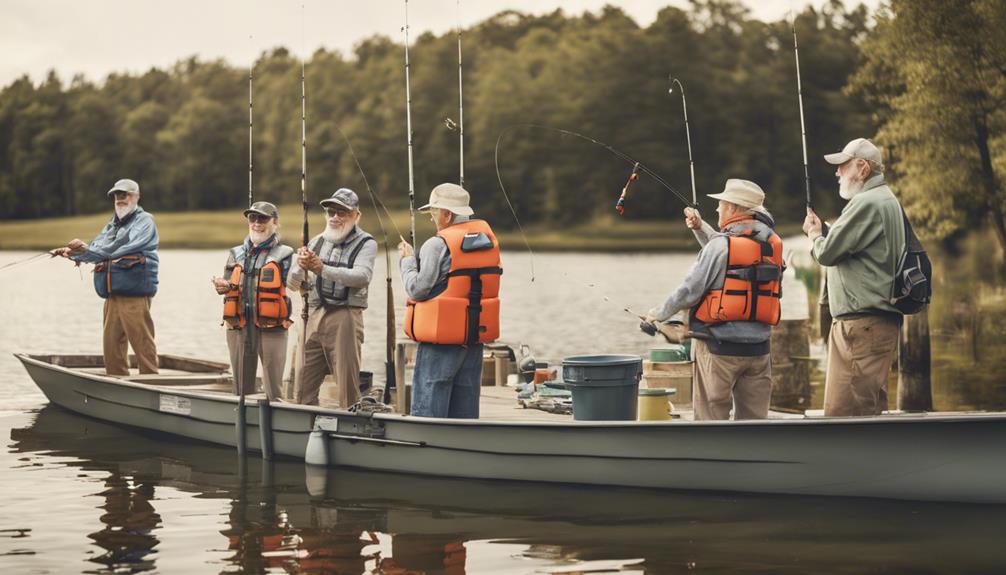Imagine you're out on a fishing trip, and suddenly a fellow angler gets a deep fishhook embedded in their hand. Knowing how to handle this situation can make a significant difference in the outcome.
But what about other common fishing mishaps? Stay prepared with essential first aid strategies that could potentially save lives and prevent further complications in unforeseen circumstances.
Bleeding Control Techniques
When dealing with bleeding during a fishing mishap, apply direct pressure to the wound to control the bleeding. Using pressure application is a crucial first step in managing bleeding effectively. By applying direct pressure to the wound with a clean cloth or bandage, you can help stop the flow of blood. Make sure to maintain this pressure continuously until help arrives or the bleeding stops.
In some severe cases where direct pressure isn't enough to control the bleeding, tourniquet use may be necessary. A tourniquet is a device that applies pressure to a limb to limit blood flow to a particular area. If the bleeding is profuse and can't be stopped with direct pressure, apply a tourniquet above the wound, ensuring it's tight enough to restrict blood flow but not too tight to cause further harm. Remember to mark the time the tourniquet was applied and communicate this information to medical professionals.
It is essential to be cautious when considering tourniquet use, as improper application can lead to complications. Only use a tourniquet as a last resort when bleeding can't be controlled by other means. Always seek professional medical help as soon as possible when dealing with severe bleeding during a fishing mishap.
Hypothermia Treatment Procedures
To effectively treat hypothermia, promptly remove wet clothing and replace it with dry, warm layers to help raise the body temperature. Preventing hypothermia is crucial when fishing in cold conditions. If someone shows signs of hypothermia such as shivering, confusion, or slurred speech, it's essential to act quickly to prevent further heat loss and potential life-threatening complications.
Emergency warming techniques are vital in treating hypothermia. Move the person to a warm, dry area as soon as possible. Remove any wet clothing and cover them with blankets or sleeping bags. If the person is conscious, offer warm beverages like tea or soup to help raise their internal temperature. Avoid alcohol or caffeine as they can worsen the situation.
In severe cases of hypothermia where the person is unconscious or their condition doesn't improve, seek immediate medical help. While waiting for assistance, continue to monitor their breathing and pulse. If necessary, perform CPR.
Fishhook Removal Methods
If you find yourself needing to remove a fishhook, follow these simple steps for safe and effective extraction. Fishhooks can be tricky to deal with, but with the right approach, you can minimize discomfort and reduce the risk of infection.
- Fishhook prevention tips: To avoid getting hooked, always be mindful of your surroundings and where your line is going. Wear protective gear like gloves when handling fish or bait, and be cautious when casting your line to prevent accidental hooking.
- Emergency response drills: It's crucial to know what to do in case of a fishhook injury. Stay calm, assess the situation, and act quickly but carefully. Having a basic understanding of first aid can make a significant difference in how well you handle the situation.
- Quick extraction tricks: One effective method for removing a fishhook is to push the hook through the skin and cut off the barb with pliers, then back the hook out the way it came in. This minimizes tissue damage and makes removal easier.
Dealing With Cuts and Wounds
In the event of cuts and wounds while fishing, promptly clean the affected area with soap and water to prevent infection. Preventing infection is crucial to ensure proper wound care. After cleaning the wound, apply an antiseptic ointment to further reduce the risk of infection. If the cut is deep or bleeding heavily, apply pressure with a clean cloth to stop the bleeding before bandaging.
Proper bandaging is essential for cuts and wounds to heal effectively. Use sterile gauze or bandages to cover the wound, making sure it isn't too tight to allow proper circulation. Change the bandage regularly, especially if it gets wet or dirty, to promote healing and prevent infection. Keeping the wound clean and covered will also protect it from exposure to dirt and bacteria.
Monitor the healing process of the cut or wound closely. Look out for signs of infection such as increased pain, redness, swelling, or discharge. If you notice any of these symptoms, seek medical attention promptly. Remember that proper wound care is essential for a speedy recovery and to prevent complications. By following these steps, you can effectively manage cuts and wounds encountered while fishing.
Handling Fish Spine Injuries
After successfully managing cuts and wounds while fishing, it's crucial to be prepared for handling fish spine injuries in order to ensure your safety and well-being during your fishing adventures. Fish spine injuries can be painful and potentially dangerous if not addressed properly.
Here are some essential tips to help you prevent and respond to fish spine injuries:
- Spine Injury Prevention: When handling fish, be cautious of their spines, which can cause injuries if not handled correctly. Avoid grabbing fish by their spines and instead use gloves or a towel to hold them securely. Additionally, be aware of the location of the spines and handle the fish with care to minimize the risk of injury.
- Emergency Response Strategies: In case of a fish spine injury, the first step is to stop the bleeding if present. Gently clean the wound with soap and water to prevent infection. If the spine is still embedded in the skin, don't try to remove it yourself; seek medical help immediately. Apply a clean bandage to the wound and keep it elevated to reduce swelling.
Treating Sunburns and Heat Exhaustion
To effectively address sunburns and heat exhaustion while fishing, prioritize immediate relief measures to alleviate discomfort and prevent further complications.
When dealing with sunburns, move to a shaded area to avoid further sun exposure. Hydrate by drinking water to cool down and prevent dehydration. Applying aloe vera or a cool compress can soothe the burn. Wearing protective clothing like long-sleeved shirts, hats, and sunglasses can prevent sunburns. Opt for light-colored and loose-fitting clothing to stay cool.
For heat exhaustion, it's crucial to rest in a cool, shaded place. Rehydrate with water or sports drinks to replenish electrolytes. Loosen tight clothing and apply cool, wet towels to the skin. If symptoms persist, seek medical help immediately. Prevention strategies include planning fishing trips during cooler times of the day and taking frequent breaks in shaded areas.
Water Safety Measures

For safer fishing experiences, always prioritize water safety measures to prevent accidents and ensure an enjoyable time on the water. When out fishing, being prepared and mindful of water safety can make a significant difference in case of emergencies.
Here are some essential water safety measures to keep in mind:
- Wear Buoyancy Aids: Before heading out on the water, ensure that everyone has a properly fitted buoyancy aid. Buoyancy aids are crucial for providing flotation in case of accidental falls into the water, especially in situations where swimming to safety might be challenging.
- Practice Proper Swimming Techniques: Knowing how to swim efficiently can be a lifesaver in emergencies. Take the time to brush up on your swimming skills or enroll in swimming lessons if needed. Additionally, familiarize yourself with basic rescue techniques to assist others in case of need.
- Stay Aware of Water Conditions: Be mindful of the water conditions at all times. Watch out for changing weather patterns, strong currents, or underwater obstacles that could pose risks. Avoid areas with known hazards and always prioritize safety over thrill.
Insect Bite and Sting Remedies
When dealing with insect bites and stings while fishing, promptly apply appropriate remedies to alleviate discomfort and prevent complications. Natural remedies can be effective in providing relief. For bee stings, scrape the area with a straight edge to remove the stinger. Apply a paste of baking soda and water or a cloth soaked in vinegar to reduce pain and swelling. Calamine lotion or hydrocortisone cream can also help.
For mosquito bites, rubbing a slice of lemon or applying a mixture of water and oatmeal can soothe itching. Aloe vera gel or tea tree oil has anti-inflammatory properties that can reduce swelling from various insect bites. Prevention tips include wearing light-colored clothing, using insect repellent, and avoiding scented products that may attract bugs.
In case of a tick bite, carefully remove the tick with fine-tipped tweezers by grasping the tick as close to the skin's surface as possible and pulling upward with steady pressure. Avoid squeezing the tick to prevent transmission of pathogens. After removal, clean the area with antiseptic and monitor for any signs of infection. Remember, being prepared with basic first aid knowledge and supplies can make a significant difference in handling insect bites and stings efficiently while enjoying your fishing adventures.
Frequently Asked Questions
What Are Some Common Types of Fish-Related Injuries That Can Occur While Fishing?
When you're out fishing, common types of fish-related injuries can include fish hook injuries and fish bites. These accidents can happen unexpectedly, so it's essential to be prepared.
Additionally, you might also face issues like heat exhaustion and sunburns while spending long hours under the sun. Remember to stay vigilant and take necessary precautions to avoid these mishaps and enjoy your fishing trip to the fullest.
How Can I Prevent Infections in Cuts and Wounds Sustained While Fishing?
To prevent infections in cuts and wounds while fishing, it is important to follow a few key steps:
Clean the wound with soap and water, apply an antiseptic, and cover it with a bandage.
Practice proper hygiene by washing your hands before and after handling fish.
Be cautious when handling fish to avoid injuries.
Have an emergency response plan in case of severe wounds.
Are There Specific First Aid Supplies I Should Always Have on Hand While Fishing?
When fishing, it's crucial to be prepared with emergency supplies. A well-stocked first aid kit is a must-have. Include items like bandages, antiseptic wipes, gauze, and adhesive tape.
Safety precautions also involve having a pair of tweezers for removing hooks. Prioritize wound care by having wound-cleaning solutions like saline solution or antiseptic sprays.
These supplies can help you address minor injuries quickly while enjoying your fishing trip.
What Are the Signs and Symptoms of Dehydration While Fishing?
To stay safe while fishing, hydration is crucial. Recognize signs of dehydration like dry mouth, fatigue, and dizziness.
Drink water regularly and wear light clothing to prevent overheating. If you feel dehydrated, take a break in the shade and rehydrate before continuing.
Knowing the symptoms and staying hydrated helps you enjoy fishing while taking care of your health.
How Can I Safely Handle Fish to Avoid Injuries?
When handling fish, remember to follow proper techniques for fish safety. Use a firm grip and avoid rough handling to prevent injuries. Always be mindful of their sharp fins and teeth.
To safely handle fish, keep them wet and supported to reduce stress and potential harm. By taking these precautions, you can enjoy fishing without risking any injuries from mishandling the catch.
Conclusion
Now that you know the top first aid strategies for fishing mishaps, you can stay prepared for any unexpected situations that may arise.
Remember to always carry a first aid kit with you and be familiar with these techniques to ensure a safe and enjoyable fishing experience.
Stay informed, stay safe, and happy fishing!



